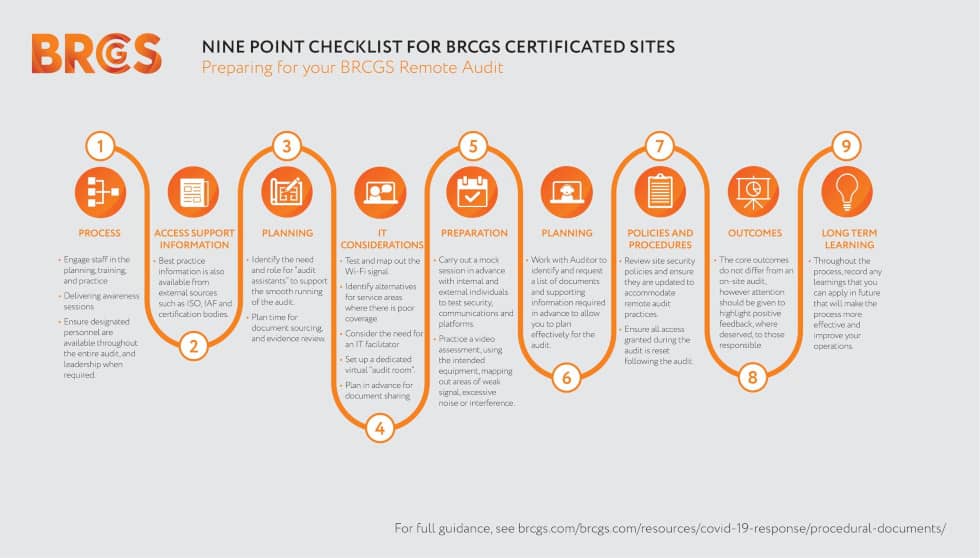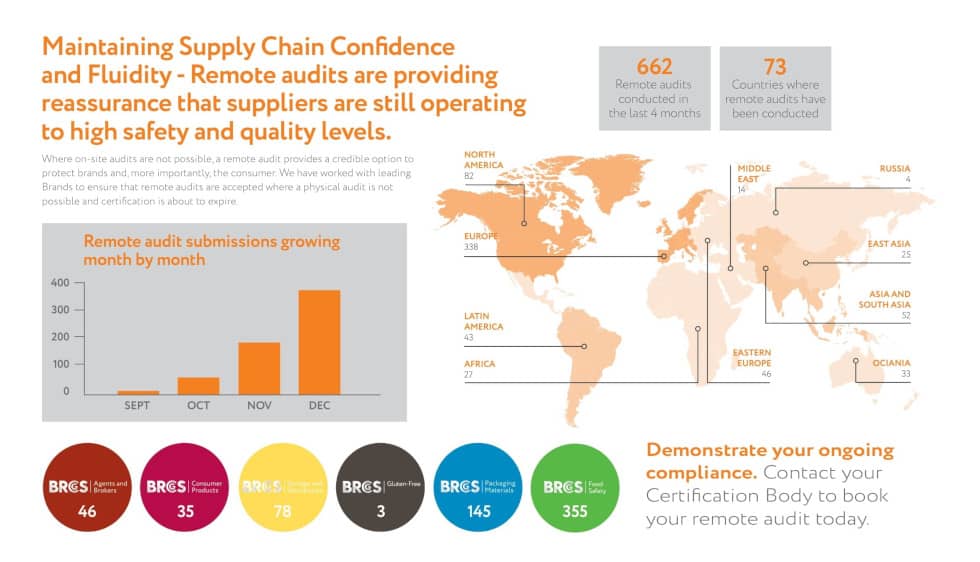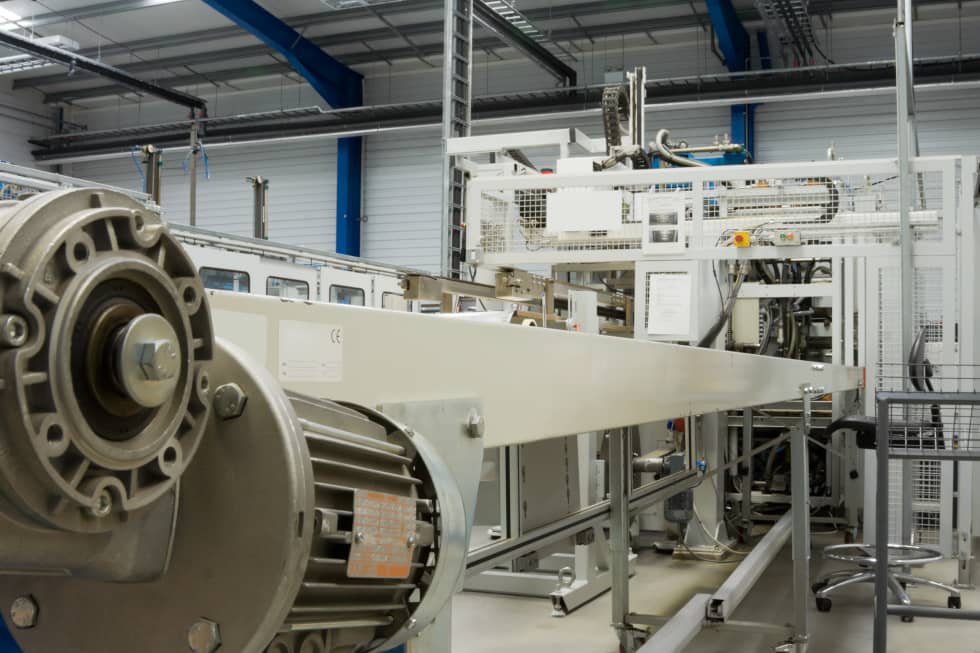
Maintaining Food Safety Standards During a Pandemic – Part 2
Preparing for a Remote Audit
The image below shows quite a detailed diagram on preparing for your remote audit to meet the BRC Food Safety Standards. It’s a nine point checklist that BRCGS offered certificated sites just to give you a flavour of what BRC proposed and what you’ll actually read later is that the feedback and the lessons learned pretty much mirrored a lot of these points.

- The Process. This is all about having to engage your staff in the planning of the audit and having the training and practice in advance. Make sure that the right people are available throughout the audits including the leadership team.
- Assess access support information. There’s lots of information out there publicly available to help you with your remote audit so go to your certification body, go through iso or even go to the international accreditation form. Lots of great information available for you to use.
- Planning is absolutely essential. Really identify who’s going to be doing what. Is there a role for audit assistance to help support the smooth running of the audit? Who’s going to hold the camera? Who’s going to gather all the evidence? Also don’t forget to plan some breaks from screen time. You need natural breaks because a remote audit is very different and it can be much more intense in many ways.
- These are IT considerations. Now you do have to test and map out your wi-fi signal throughout your site. It would probably be a great idea to have an IT person available throughout the audit. Plan in advance how to share documents and maybe set up a separate audit room. There’s lots of planning that needs to be done there and having a designated room is a great idea.
- Preparation. So do a mock test of the equipment with internal and external people. Identify your weak wi-fi signal areas. Test that the lighting on site is good enough so that the auditor is going to be able to see everything clearly from their remote screen. You can send them a map of the site so they know in advance the location of everything.
- More planning again is absolutely imperative. This time in conjunction with your auditor in advance of the audit day. Try and identify what documents need to be ready and which can be sent in advance.
- Company policies. It is particularly important to consider site security policies, both the site security policies of the auditor and the certification bodies. Just make sure that all the systems are communicating with each other and can be shared and accessed remotely. Auditors have reported their feedback where they’ve struggled with this consideration.
- Making sure that the outcomes of the audit are followed through as they should be.
- Particularly important is to take any of the experience that you’ve gained from the audits and reuse them the next time. Again that is some feedback that we’ve had from auditors that the more they’ve done these remote audits, the easier it’s become.

We know that approximately 20,000 food safety audits took place in the last 12 months and a small percentage were remote audits and blended audits.
We wanted to share a little bit of how that’s worked regarding maintaining supply chain confidence and fluidity. Remote audits are providing reassurance that suppliers are still operating to high safety and quality levels. This is based on the BRCGS remote audits done globally.
During the pandemic what we can see is that there was an increasing trend of remote audits taking place between September 2020 and December 2020 across the globe. In total there were 662 remote audits and they were conducted in 73 countries. Of these, 46 were remote agents and broker audits, 78 were storage and distribution audits, 145 were remote packaging material audits and 355 remote food safety audits.
We can also see it split up by country and about 50 percent of those audits were conducted in Europe, a total of 338 of them. This shows us that the sites, the certification bodies and auditors all got on board reasonably quickly with the new audit options available to them. Their confidence grew as they got used to this new way of working and we can see that reflected in the number of audits done from September right through to December.
In a typical year, approximately 20,000 or more food audits would be completed to the BRCGS food standard. We did see a slight drop off initially during the pandemic but that picked up as the year went on and by January 2021 the number of audits completed were actually more or less the same year-on-year.
We can assume that there have also been less visits overall to sites by specifiers and customers and the question is, has this led to complacency? We will explore this later on in the article.
There was much feedback from the auditors that conducted these remote audits. For them, it was actually quite a bit of a culture shock as well as the site owners as neither had much experience with these that led to a few issues. Many sites hadn’t thought about investing in much of the necessary equipment so there were complaints of poor quality headphones, poor wi-fi in some or all areas, poor lighting that made it very difficult for the auditor to see the standard of construction, and so on. It made a lot of auditors realize how much they rely on the sense usually while conducting an audit, observing the environment and listening to interactions between employees. These were all challenges to a remote audit.
Another issue was that some companies were nervous about releasing their documentation over email but measure such as non disclosure agreements were used to allay most of those fears.
So auditors were initially quite sceptical about how video observations of facilities would work out, given that auditors would lose most of their senses except sight when viewing remotely and the video presentation indeed does not replace a walkthrough of the facility. You do really need to be present on site to get the full experience of the culture of the company and its staff through its operational practices but video does afford some understanding of the process and the overall standard of construction and equipment.
It gives you a pretty good idea about the housekeeping and the hygiene and the general current operating standards.
Some specifiers did want their usual auditor to do the remote audit instead of a new one because they are already familiar with the site layout and they know where the blind spots are but then we also heard that new auditors were seeing new non-conformances because they were less familiar with the site. So by having a new auditor and also by having the documentation in advance this could actually allowed the auditor time to do a more in-depth risk assessment and therefore some sites saw an increase in documentation for non-conformances
We will continue to discuss further lessons that were learned during the pandemic in our 3rd part of this series of articles.

